Abstract
Incubation of (8R)- and (8S)-[1-14C]hepoxilin A3 [where hepoxilin A3 is 8-hydroxy-11,12-epoxyeicosa-(5Z,9E,14Z)-trienoic acid] and glutathione with homogenates of rat brain hippocampus resulted in a product that was identified as the (8R) and (8S) diastereomers of 11-glutathionyl hepoxilin A3 by reversed-phase high performance liquid chromatographic comparison with the authentic standard made by total synthesis. Identity was further confirmed by cleavage of the isolated product with gamma-glutamyltranspeptidase to yield the corresponding cysteinylglycinyl conjugate that was identical by reversed-phase high performance liquid chromatographic analysis with the enzymic cleavage product derived from the synthetic glutathionyl conjugate. The glutathionyl and cysteinylglycinyl conjugate are referred to as hepoxilin A3-C and hepoxilin A3-D, respectively, by analogy with the established leukotriene nomenclature. Formation of hepoxilin A3-C was greatly enhanced with a concomitant decrease in formation of the epoxide hydrolase product, trioxilin A3, when the epoxide hydrolase inhibitor trichloropropene oxide was added to the incubation mixture demonstrating the presence of a dual metabolic pathway in this tissue involving hepoxilin epoxide hydrolase and glutathione S-transferase processes. Hepoxilin A3-C was tested using intracellular electrophysiological techniques on hippocampal CA1 neurons and found to be active at concentrations as low as 16 nM in causing membrane hyperpolarization, enhanced amplitude and duration of the post-spike train afterhyperpolarization, a marked increase in the inhibitory postsynaptic potential, and a decrease in the spike threshold. These findings suggest that these products in the hepoxilin pathway of arachidonic acid metabolism formed by the rat brain may function as neuromodulators.
Full text
PDF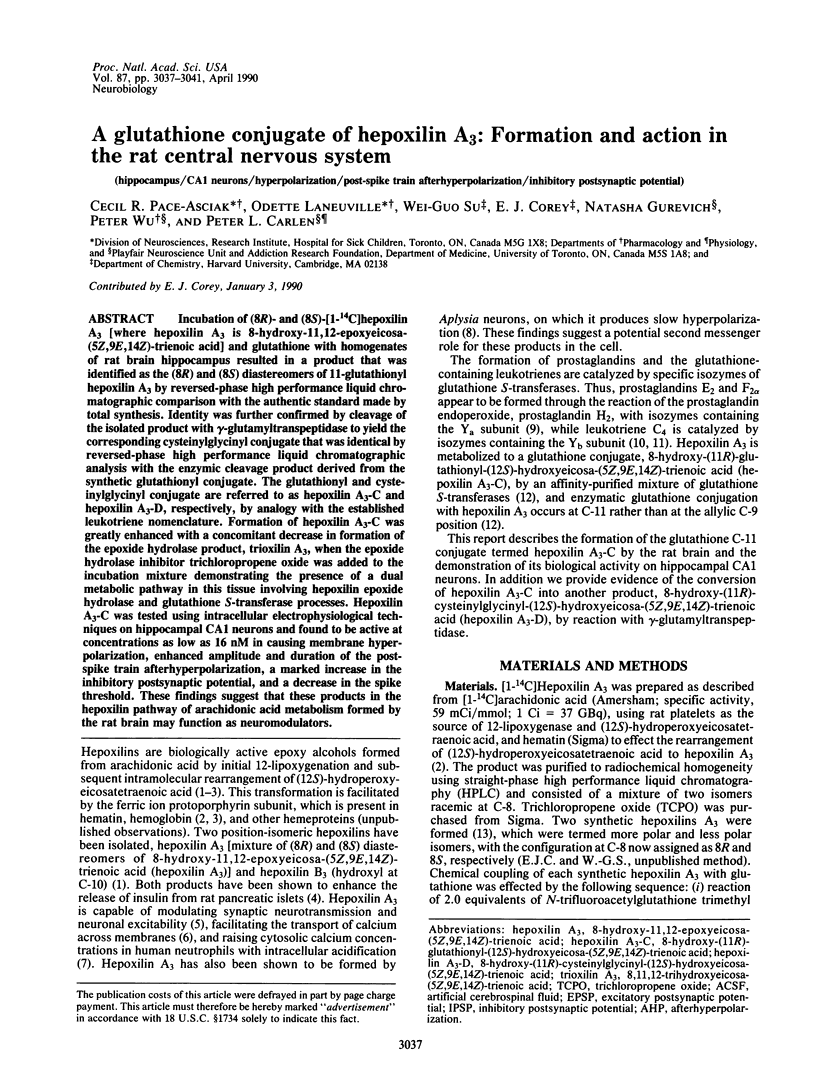
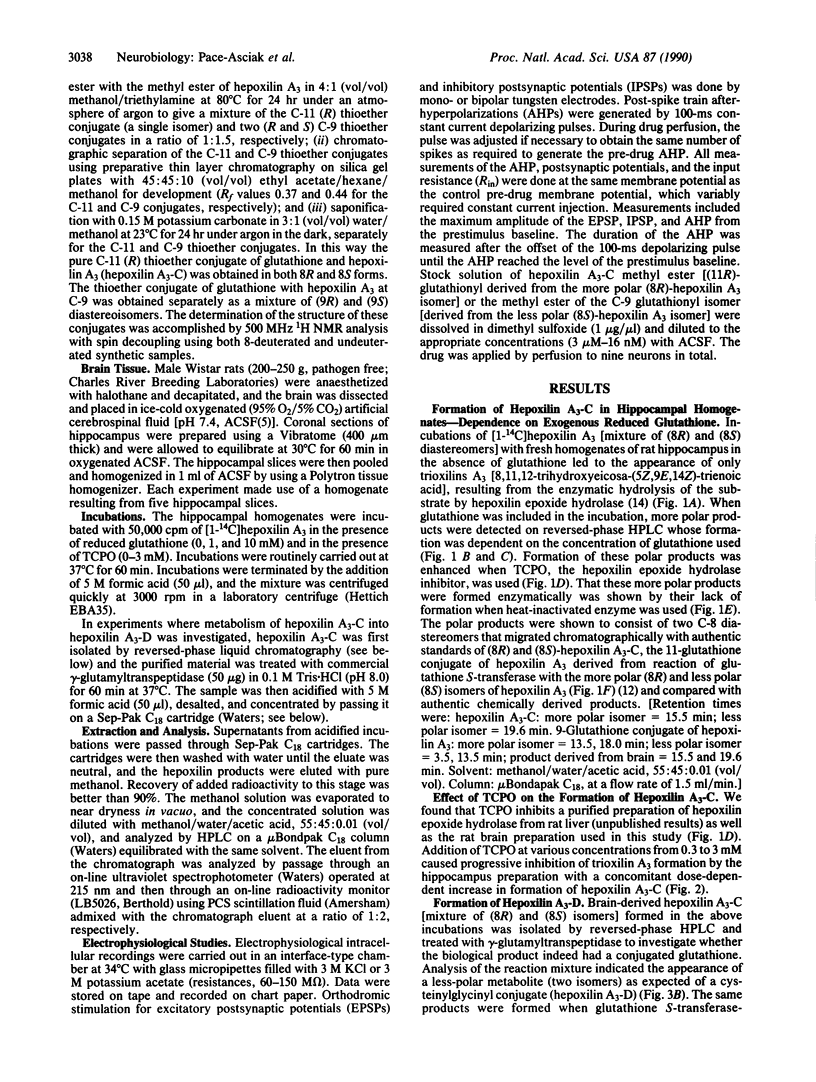
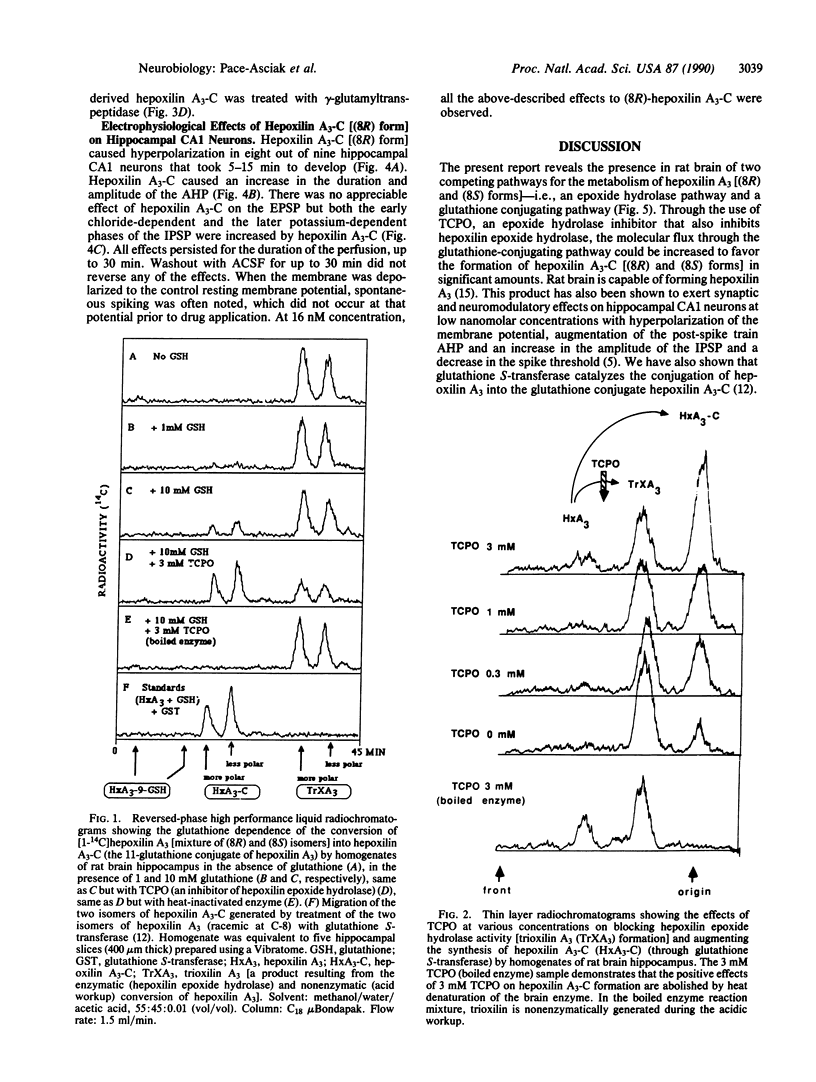
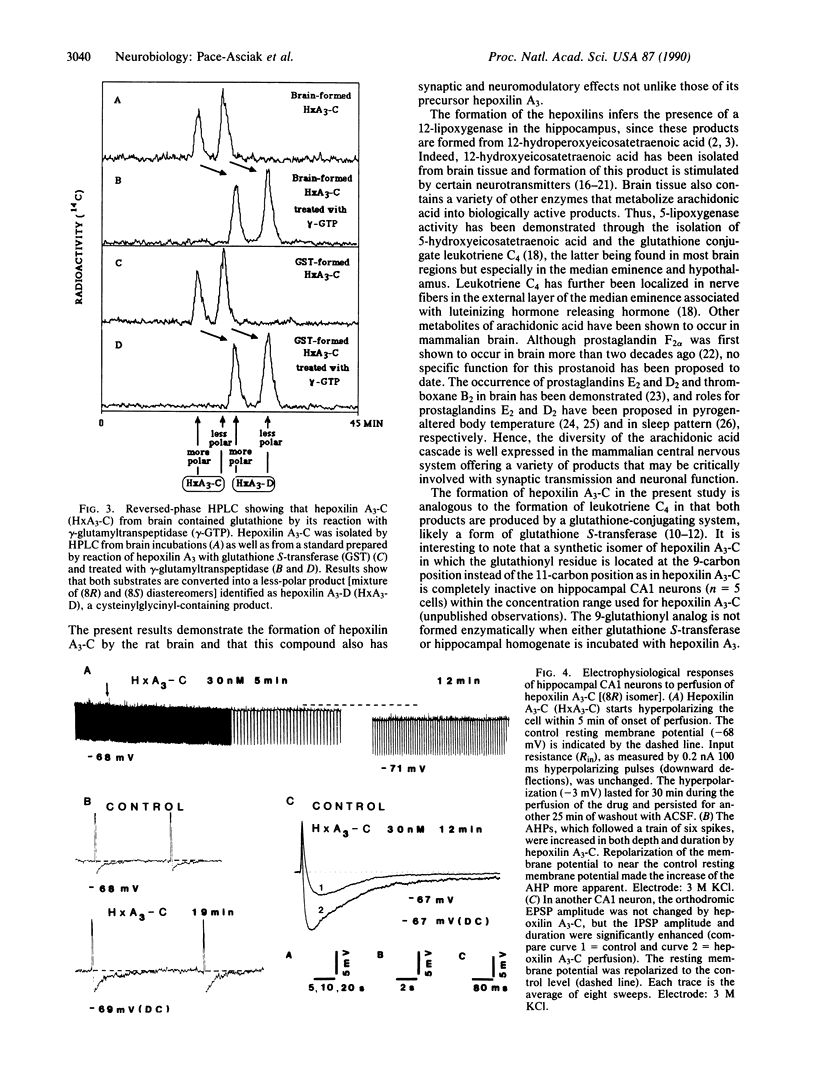
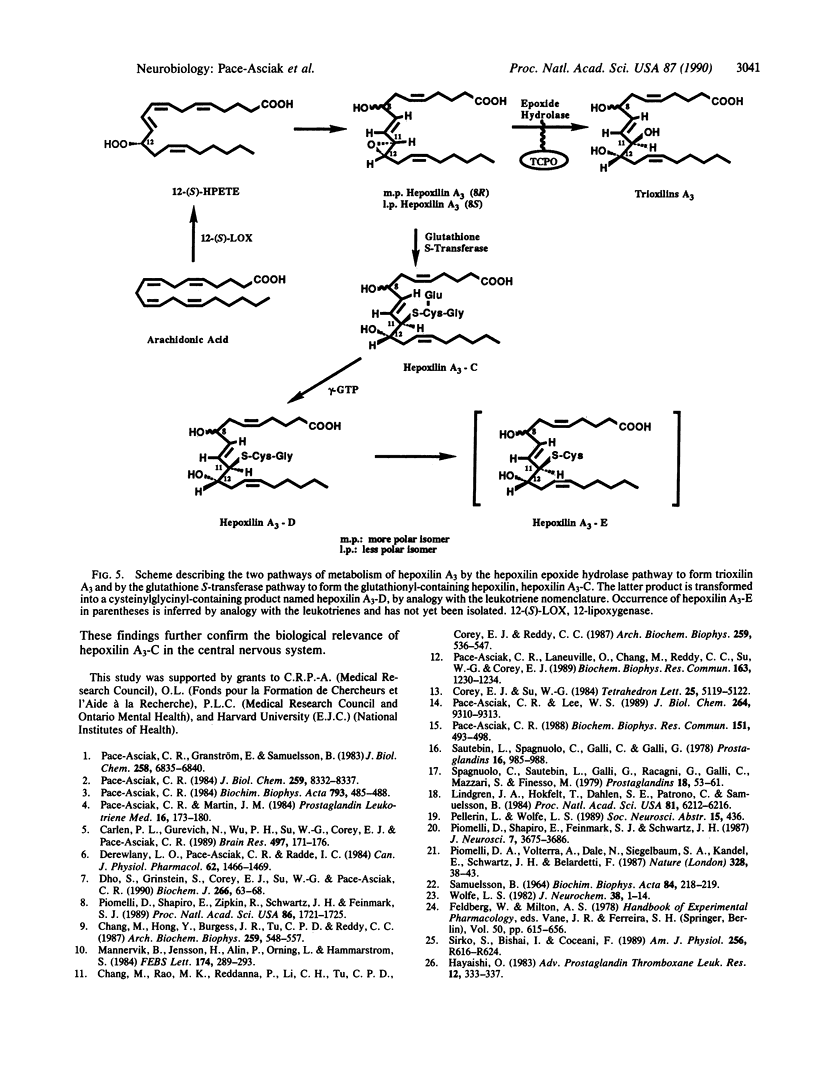
Selected References
These references are in PubMed. This may not be the complete list of references from this article.
- Carlen P. L., Gurevich N., Wu P. H., Su W. G., Corey E. J., Pace-Asciak C. R. Actions of arachidonic acid and hepoxilin A3 on mammalian hippocampal CA1 neurons. Brain Res. 1989 Sep 11;497(1):171–176. doi: 10.1016/0006-8993(89)90984-0. [DOI] [PubMed] [Google Scholar]
- Chang M., Hong Y., Burgess J. R., Tu C. P., Reddy C. C. Isozyme specificity of rat liver glutathione S-transferases in the formation of PGF2 alpha and PGE2 from PGH2. Arch Biochem Biophys. 1987 Dec;259(2):548–557. doi: 10.1016/0003-9861(87)90521-2. [DOI] [PubMed] [Google Scholar]
- Chang M., Rao M. K., Reddanna P., Li C. H., Tu C. P., Corey E. J., Reddy C. C. Specificity of the glutathione S-transferases in the conversion of leukotriene A4 to leukotriene C4. Arch Biochem Biophys. 1987 Dec;259(2):536–547. doi: 10.1016/0003-9861(87)90520-0. [DOI] [PubMed] [Google Scholar]
- Derewlany L. O., Pace-Asciak C. R., Radde I. C. Hepoxilin A, hydroxyepoxide metabolite of arachidonic acid, stimulates transport of 45Ca across the guinea pig visceral yolk sac. Can J Physiol Pharmacol. 1984 Dec;62(12):1466–1469. doi: 10.1139/y84-243. [DOI] [PubMed] [Google Scholar]
- Dho S., Grinstein S., Corey E. J., Su W. G., Pace-Asciak C. R. Hepoxilin A3 induces changes in cytosolic calcium, intracellular pH and membrane potential in human neutrophils. Biochem J. 1990 Feb 15;266(1):63–68. doi: 10.1042/bj2660063. [DOI] [PMC free article] [PubMed] [Google Scholar]
- Hayaishi O. Prostaglandin D2: a neuromodulator. Adv Prostaglandin Thromboxane Leukot Res. 1983;12:333–337. [PubMed] [Google Scholar]
- Lindgren J. A., Hökfelt T., Dahlén S. E., Patrono C., Samuelsson B. Leukotrienes in the rat central nervous system. Proc Natl Acad Sci U S A. 1984 Oct;81(19):6212–6216. doi: 10.1073/pnas.81.19.6212. [DOI] [PMC free article] [PubMed] [Google Scholar]
- Mannervik B., Jensson H., Alin P., Orning L., Hammarström S. Transformation of leukotriene A4 methyl ester to leukotriene C4 monomethyl ester by cytosolic rat glutathione transferases. FEBS Lett. 1984 Oct 1;175(2):289–293. doi: 10.1016/0014-5793(84)80753-x. [DOI] [PubMed] [Google Scholar]
- Pace-Asciak C. R. Arachidonic acid epoxides. Demonstration through [18O]oxygen studies of an intramolecular transfer of the terminal hydroxyl group of (12S)-hydroperoxyeicosa-5,8,10,14-tetraenoic acid to form hydroxyepoxides. J Biol Chem. 1984 Jul 10;259(13):8332–8337. [PubMed] [Google Scholar]
- Pace-Asciak C. R. Formation and metabolism of hepoxilin A3 by the rat brain. Biochem Biophys Res Commun. 1988 Feb 29;151(1):493–498. doi: 10.1016/0006-291x(88)90620-1. [DOI] [PubMed] [Google Scholar]
- Pace-Asciak C. R., Granström E., Samuelsson B. Arachidonic acid epoxides. Isolation and structure of two hydroxy epoxide intermediates in the formation of 8,11,12- and 10,11,12-trihydroxyeicosatrienoic acids. J Biol Chem. 1983 Jun 10;258(11):6835–6840. [PubMed] [Google Scholar]
- Pace-Asciak C. R. Hemoglobin- and hemin-catalyzed transformation of 12L-hydroperoxy-5,8,10,14-eicosatetraenoic acid. Biochim Biophys Acta. 1984 May 11;793(3):485–488. doi: 10.1016/0005-2760(84)90267-4. [DOI] [PubMed] [Google Scholar]
- Pace-Asciak C. R., Laneuville O., Chang M., Reddy C. C., Su W. G., Corey E. J. New products in the hepoxilin pathway: isolation of 11-glutathionyl hepoxilin A3 through reaction of hepoxilin A3 with glutathione S-transferase. Biochem Biophys Res Commun. 1989 Sep 29;163(3):1230–1234. doi: 10.1016/0006-291x(89)91109-1. [DOI] [PubMed] [Google Scholar]
- Pace-Asciak C. R., Lee W. S. Purification of hepoxilin epoxide hydrolase from rat liver. J Biol Chem. 1989 Jun 5;264(16):9310–9313. [PubMed] [Google Scholar]
- Pace-Asciak C. R., Martin J. M. Hepoxilin, a new family of insulin secretagogues formed by intact rat pancreatic islets. Prostaglandins Leukot Med. 1984 Nov;16(2):173–180. doi: 10.1016/0262-1746(84)90069-6. [DOI] [PubMed] [Google Scholar]
- Piomelli D., Shapiro E., Feinmark S. J., Schwartz J. H. Metabolites of arachidonic acid in the nervous system of Aplysia: possible mediators of synaptic modulation. J Neurosci. 1987 Nov;7(11):3675–3686. doi: 10.1523/JNEUROSCI.07-11-03675.1987. [DOI] [PMC free article] [PubMed] [Google Scholar]
- Piomelli D., Shapiro E., Zipkin R., Schwartz J. H., Feinmark S. J. Formation and action of 8-hydroxy-11,12-epoxy-5,9,14-icosatrienoic acid in Aplysia: a possible second messenger in neurons. Proc Natl Acad Sci U S A. 1989 Mar;86(5):1721–1725. doi: 10.1073/pnas.86.5.1721. [DOI] [PMC free article] [PubMed] [Google Scholar]
- Piomelli D., Volterra A., Dale N., Siegelbaum S. A., Kandel E. R., Schwartz J. H., Belardetti F. Lipoxygenase metabolites of arachidonic acid as second messengers for presynaptic inhibition of Aplysia sensory cells. Nature. 1987 Jul 2;328(6125):38–43. doi: 10.1038/328038a0. [DOI] [PubMed] [Google Scholar]
- SAMUELSSON B. IDENTIFICATION OF A SMOOTH MUSCLE-STIMULATING FACTOR IN BOVINE BRAIN. PROSTAGLANDINS AND RELATED FACTORS 25. Biochim Biophys Acta. 1964 Apr 20;84:218–219. [PubMed] [Google Scholar]
- Sautebin L., Spagnuolo C., Galli C., Galli G. A mass fragmentographic procedure for the simultaneous determination of HETE and PGF2alpha in the central nervous system. Prostaglandins. 1978 Dec;16(6):985–988. doi: 10.1016/0090-6980(78)90115-6. [DOI] [PubMed] [Google Scholar]
- Sirko S., Bishai I., Coceani F. Prostaglandin formation in the hypothalamus in vivo: effect of pyrogens. Am J Physiol. 1989 Mar;256(3 Pt 2):R616–R624. doi: 10.1152/ajpregu.1989.256.3.R616. [DOI] [PubMed] [Google Scholar]
- Spagnuolo C., Sautebin L., Galli G., Racagni G., Galli C., Mazzari S., Finesso M. PGF2 alpha, thromboxane B2 and HETE levels in gerbil brain cortex after ligation of common carotid arteries and decapitation. Prostaglandins. 1979 Jul;18(1):53–61. doi: 10.1016/s0090-6980(79)80023-4. [DOI] [PubMed] [Google Scholar]
- Wolfe L. S. Eicosanoids: prostaglandins, thromboxanes, leukotrienes, and other derivatives of carbon-20 unsaturated fatty acids. J Neurochem. 1982 Jan;38(1):1–14. doi: 10.1111/j.1471-4159.1982.tb10847.x. [DOI] [PubMed] [Google Scholar]


